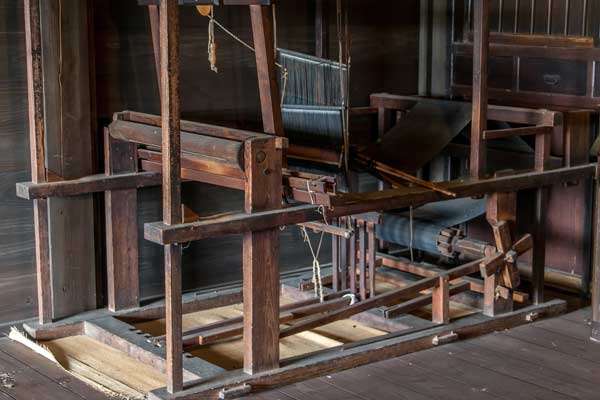Weaving & Looms
Discover the World’s Finest Wool – Weaving & Looms
What exactly is Weaving?
Weaving is one of the oldest manufacturing textile techniques. At least two thread systems, the warp thread and the weft thread are crossed at right angles.
The pre-tensioned warp threads form the carrier, into which the weft threads are drawn one after the other from one selvage to the other across the entire width of the weave. The product is known in the technical language as a woven fabric, which includes cloth and other products, such as woven carpets or wallpapers.
The weaving technique differs from that of braiding in that in braiding, the threads do not cross at right angles but diagonally.
The device required for weaving is the loom. The original handloom was improved throughout thousands of years. It became increasingly automated from the 18th century onwards and was finally replaced by electronically controlled weaving machines in the course of the industrial revolution.
Today, the vast majority of woven fabrics in worldwide production are manufactured by machine.
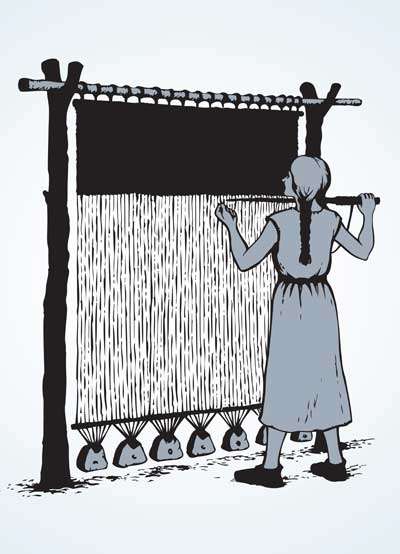
The History of Weaving
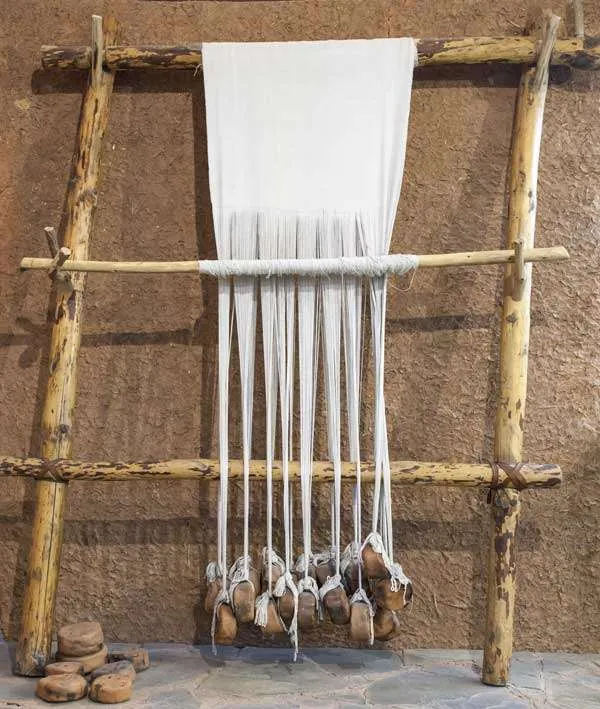
Due to the transience of the material, it is unfortunately not possible to determine precisely when the history of weaving began. What is certain is that weaving is one of the oldest crafts performed by humans. About 30,000 years old are the most ancient textile remains that have been found so far. They come from the Caucasus and consist of flax and nettle fibers. Fabric remains of robes were found in the burial chambers of Egyptian antiquity.
In the beginning, there was the thread
Long before humans invented weaving, plant fibers were already twisted into threads in the Paleolithic Age. The twisted threads were later braided and knotted into nets.
Neolithic period
When the people settled down, they began to grow flax for fiber production. The flax fibers from the stems of plants were spun into fine threads – these threads were stretched on a wooden weaving frame. In contrast to today, these looms stood on a wall. Heavy Weights made of clay ensured that the warp threads were pulled down. It was woven from top to bottom.
Some researchers assume that weaving was already done in the early Palaeolithic. A number of Neolithic textiles made either of flax or wool have survived from some wetland settlements of Switzerland.
Bark bast (from lime, elm and oak) was also used. Standing Weight looms were used until the Middle Ages. The weaving material of the Bronze Age is known mainly from the finds of Danish tree coffins.1
The Wool Sheep – First Weaving of animal fibers.
The first sheep that were kept by people of the Neolithic Age were kept mainly for the meat. The wool fleece was not yet suitable for Wool extraction because the animal hairs were too short. Only since about the early Bronze Age, around 2000 B.C. animal hair was spun and woven. Discoveries around 1000 B.C. show fine woolen fabrics, which were woven in different colors in different and elaborate patterns.
Weaving in the antique epoch
The Romans made the same use of exquisite fabrics from the Orient as the Greek culture. The import of these elaborate weavings reached its peak in the Roman Empire (approx. 375 AD). Among them were also garments made of Chinese silk, which were woven in the Near East or directly manufactured in China.
In the 6th century, Byzantium, with its artistic weaving, came to the forefront. The introduction of silkworm breeding in Persia certainly contributed to this. (approx. 550 A.D.)
Justinian’s cloth factories were expanded, and these Persian-Sasanid patterns were imitated. Based on occidental culture, independent mosaic-like fabric patterns also developed here.
In the course of time, weaving skills gradually increased also in Central and Northern Europe, so that during the Migration Period, in addition to plain fabrics, already very fine fabrics were produced.
Fabrics that were interwoven with bronze or gold threads were already known in the Bronze Age. Even flannel-like fabrics already existed at this time (approx. 375 -568 A.D.).
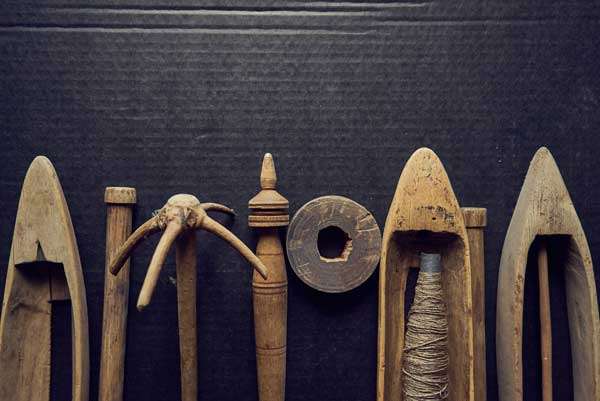
Weaving from the early Middle Ages to the Renaissance
Until the 12th century, the oriental element remained predominant in weaving in southern Europe. Medieval silk fabrics with predominantly geometric patterns came from Spain, but Islam continued to dominate the pictorial forms of weaving.
In Sicily, under the Norman domination around 1140, the Saracens weaving was introduced and made available to Italian Christians. Palermo developed into a center of artistic weaving.
Woven textiles and carpets helped traders like the Assyrians, Babylonians and later the Phoenicians to their wealth. They were able to maintain their technical lead in the textile industry in Asia Minor, Persia and Arabia until the 13th century.
In the 13th and 14th centuries, silk weaving mills were established in Lucca, Venice, Florence, Genoa and Milan – mostly with oriental workers.
The patterns underwent a complete transformation by removing the division of fields. The result was a free, alternating arrangement of plant motifs in rows between humans and animals, based on a combination of occidental and oriental motifs and, therefore, generally referred to as Arab-Italian Style.
The color scheme was predominantly red and green, with individual parts of the design brocaded with horizontal stripes of gold in between. Such fabrics were mainly used for the decoration of churches.
In the 15th century, the pomegranate pattern began to dominate the fabrics of the weaving mills, which were artistically woven in fabrics of soft velvet.
The velvet fabrics were used both – for clothing and for wallpaper. Only with the Spanish costume, which became fashionable in the 16th century – due to their tight folding – smaller and more decent patterns became popular again.
For larger areas, the Renaissance period created the most varied forms of the pomegranate motif on vases and in bouquets, in combination with oriental flowers that appear in oval fields.
The acanthus pattern was also widely used – until the 17th century, for traditional costume fabrics and smaller scattered patterns – predominantly used in Italian products.2
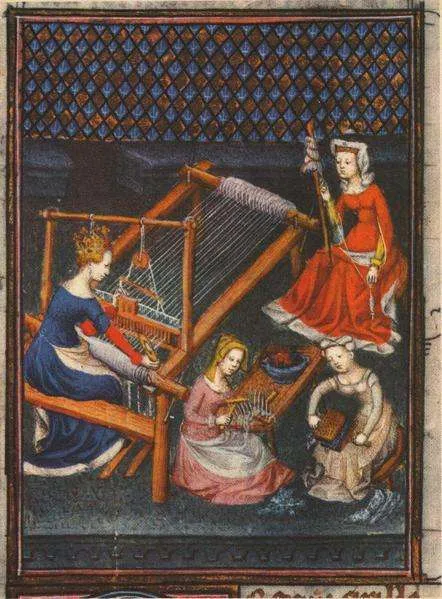
Weaving in 15th century Europe- by Mulieribus Claris © [Public Domain]
A short history of the evolution and development of looms
Do you necessarily need a weaving frame or loom for weaving?
There are weaving techniques that do not require a weaving frame or loom, for example, the so called tablet weaving. However, a weaving frame can also be used for these techniques, which is more practical and has several advantages.
A weaving frame solves the problem that the warp threads lie next to each other in an orderly fashion and are evenly tensioned.
This makes it easy to cross the weft threads at right angles and produce an even fabric. In order to tension the threads, different systems have been developed in different cultures, depending on the available resources and the state of technical knowledge.
The History of the Loom
First usage of looms for weaving
Since the predecessors of today’s looms were made of perishable materials, there is hardly any evidence of their appearance. Consequently, one is dependent on early historical texts, pictorial representations and excavations.
Although there is no reliable information, it is assumed that the warp was originally stretched horizontally, then moved to a vertical arrangement and finally returned to a horizontal one.
However, some researchers consider the vertical weight loom to be the oldest weaving machine. This loom was very widespread, but whether this construction is older than the weaving frame that was used early on, especially in China, cannot be answered exactly.
The oldest illustration of a horizontal weaving frame is an incised drawing on the inside of a ceramic bowl from a Badari tomb in Egypt, dated around 4400 BC.3
In Europe, the use of weight looms has been proven since the Neolithic period. Until Roman antiquity, the weight loom was probably the only weaving device used in Europe.
There are wall paintings and grave gifts with weaving women from the 11th and 12th Dynasties of Egypt (about 2000 BC). Woven Fabrics are known from much earlier times, but there is no older information about the weaving equipment used. Pictures and grave goods give an impression of the weaving equipment used at that time. These vertical Looms of Egypt were probably brought to Europe by the Romans.
Already in ancient times, the Chinese produced silk fabrics and brought them via the Silk Road to the Mediterranean Sea. The production, however, remained a closely guarded secret for a long time. Therefore, not much is known about the development of oriental weaving. Probably the Arabs brought their looms from the East to Central Europe in the early Middle Ages.
High warp tapestry looms have been used in Europe for pictorial weaving for a long time.4
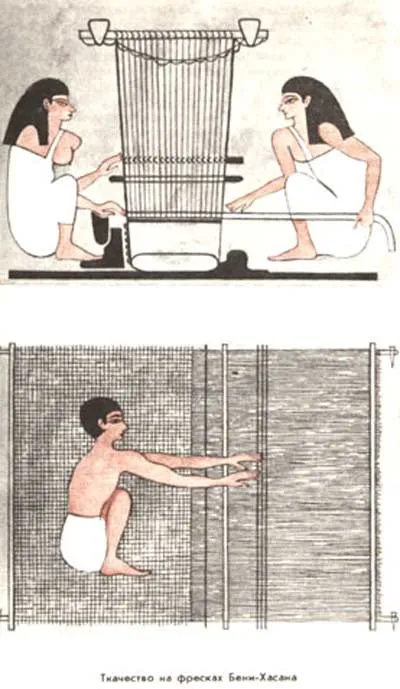
Further development of the loom
From the Byzantine period (around 600 A.D.), various illustrations of a “pit loom” are known. These pit looms were a further step in the development of the looms – they were the first to use shafts whose position could be changed with the feet.
Another new feature was the use of a weaving comb, which held the warp threads in their position and at the same time enabled the weft thread to be guided smoothly into the fabric. Instead of a simple wooden stick, the shuttle with integrated bobbin – on which the thread could be winded – was soon used for the weft thread.
As a further development of the pit loom, the first treadle looms were developed in the Middle Ages.
The treadle loom was probably first used in Syria, Iran and Islamic East Africa. Around 1177 the Moors in southern Spain enhanced the treadle loom by placing it on a very strong frame high above the ground.
The position of the weaving heddles was changed by feet, and the weaver had both hands free to work with the weaving shuttle. Later this type of loom became the most used standard in medieval Europe in the 11th century. The treadle loom had completely replaced the vertical weight loom. A fundamental change in weaving technique did not occur anymore until about the middle of the 18th century.
The fabrics were woven in private households and then sold at markets. The craft of weaving spread, and the first guilds were founded.
Weaving began to flourish as an industry in Europe. In Augsburg during the Fugger merchant dynasty, there existed a weaving guild with over 700 members in the middle of the 15th century.
Many villages and towns, with a high proportion of weavers, held their own weaving markets. Over centuries, so-called house weaving businesses were established, which provided an additional meager source of income in homework.
Invention of the Power Loom by Edward Cartwright
In 1733, John Kay invented the Flying shuttle, which almost doubled the speed of weaving. However, the threads were still spun by hand until far into the 18th century. Four to ten spinners had to work for one weaver to provide him with enough yarn for his work.
With the invention of the mechanical spinning machine – the Spinning Jenny in 1767, the spinning process became also much more productive. Now one spinner was enough to supply a weaver with enough material.
In April 1743, Edmund Cartwright was born in England. He developed the first functional mechanical loom called “Power Loom“. This machine was an important element of the Industrial Revolution.
In 1784, Cartwright began to develop a mechanical loom, because unlike his contemporaries, he believed that weaving could also be automated. The following year he received his first patent for a weaving machine that had to be driven by a hand crank.
In 1786 he applied for a patent for further development of his loom. A new mechanical drive was used for the moving parts of the loom. This further development made it possible to operate the loom with steam and became famous as the Power Loom.
Edmond Cartwright’s invention did not become generally accepted until around 1830.5
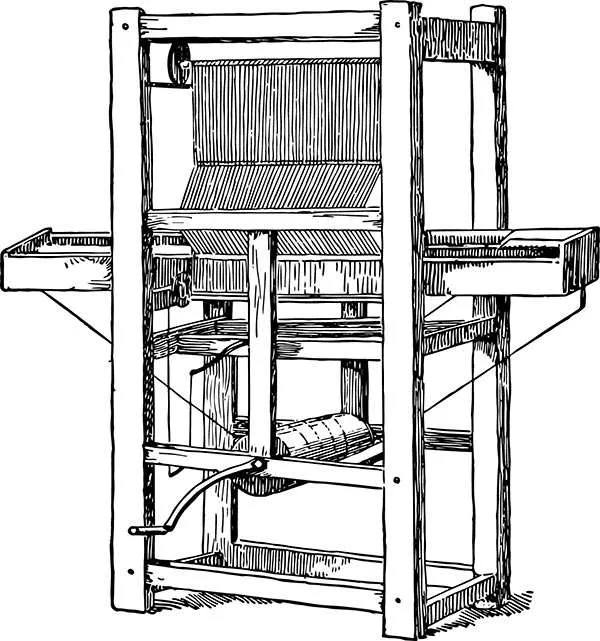
The Power Loom and the Industrial Revolution
The Power Loom, in combination with the steam engine, is considered one of the origins of the so-called Industrial Revolution. Because now a large number of high-quality products could be produced at a low cost. What used to be a luxury article now became accessible to a broader population.
But fewer machine operators were needed than before in the production process, which often took place at home with the whole family. The rationalization of the work began, which continues to this day. As a result, all those who previously spun threads by hand and woven the fabrics either became unemployed and fell into poverty or had to work in factories.
The introduction of the mechanical looms reduced the demand for skilled hand-weavers, which initially led to lower wages and unemployment. The introduction of the power loom was followed by protests and weaver revolts in Germany and England. Rioting weavers tried to destroy the new machine weaving mills and attacked the workers.
It was therefore not uncommon for factory owners to surround their buildings with high walls, block the gates during shifts and in some cases even set up cannons loaded with shrapnel to demotivate potential strikers.
In the long-term, the power looms increased demand and stimulated exports by making cloth much cheaper, which in turn increased industrial employment, albeit at low wages. Within 50 years, the number of mechanical looms in England increased a hundredfold.
The inventor and clergyman Edmund Cartwright died on October 30, 1823, in Kent, England. Of his invention, the Power Loom, 250,000 were sold solely in England.6
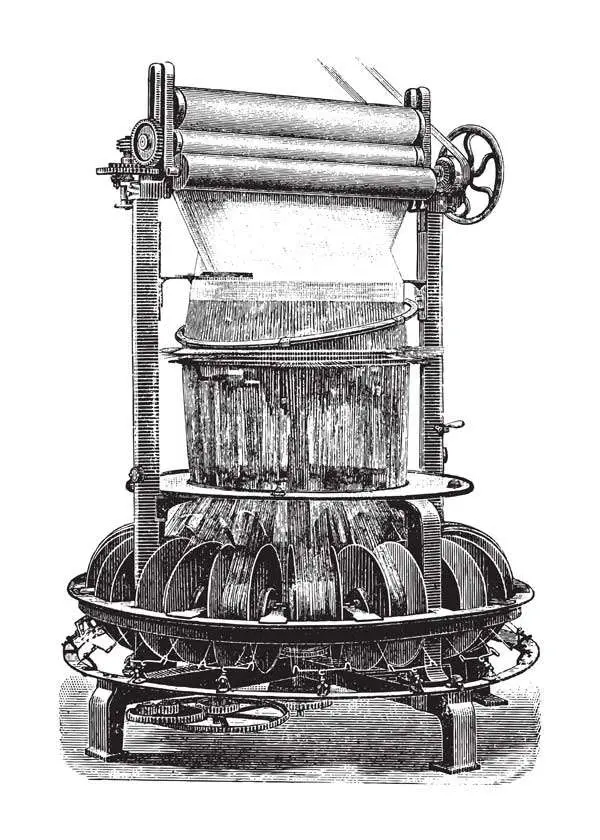
Weaving in Other Cultures
Weaving arts of the Maya
Elaborate weaving techniques and colorful patterns are the hallmarks of Maya textiles from the highlands of Guatemala, considered the most important and diverse in all of Latin America.
The art of weaving has a more than thousand-year-old tradition among the Maya, which was practiced by women. This craft was connected with the gift of giving birth.
Due to the humid climate, only a few textiles from the pre-Columbian epoch have been preserved. Most of the discoveries were made in the sacrificial well of Chichen Itza, where the mud protected them from oxygen and thus kept them from rotting.

In the southern Mayan lowlands in the town of Rio Azur, fragments of cloth from the period between 250 and 550 AD have been discovered. The fibers of the Henequén Agave or cotton were used for weaving. Cotton, as could be proven by pollen, was already being cultivated in Central America in 1500 BC.
The textiles produced were used for personal consumption, to pay tributes to the ruling class, or they were intended for trade. On old pictures of art, you can still see today the fashion of the Maya, which was typical for the development epochs.
When the Spanish invaders appeared, the clothing changed fundamentally. One reason for this was the appearance of new materials such as silk and wool, as well as the technique used in their production. Now a pedal loom was used, which was operated exclusively by men.7
The weaving arts of the Incas

The wool of the llama, alpaca, vicuna and guanaco was spun by both women and men. The result was the highest quality of fabrics. In the processing of wool into fabrics, the Incas relied on the excellent craft traditions of the ancient Peruvian cultures.
The wool processed for weaving was often dyed. For example, the seeds of the avocado tree were used to produce a blue color. For other colors, the Incas also knew different minerals, such as copper and tin.
Gold and silver plates were also sewn onto the tunics of the dignitaries. Three different types of looms were used to produce fabrics and cloth from the wool – called “Ahuana” in the Quechua language.8
See How Indigenous Weaving Styles Are Preserved in Guatemala | National Geographic
The handcraft of weaving today
- In some developing countries, there are still more handlooms in operation than weaving machines for commercial purposes.
- In India, more than 7 billion m² of fabric was produced on approximately 2.4 million handlooms in 2010.
- There exist some designer weaving workshops for exclusive products.
- Weaving is sometimes offered as an activity in charitable institutions and rehabilitation centers.
- Many people practice wool craft from carding raw wool to spinning and hand weaving back home again, and this hobby is getting more and more popular.


Free Amigurumi Pattern for Beginners

Alpaca Sweater vs Cashmere Sweater

Shopping in Lima – Markets for Alpaca fashion and souvenirs in Lima?

HIKING IN WINTER – TIPS FOR HIKING IN THE COLD SEASON

Arequipa’s Alpaca Magic: Industry Insights, Tours, and Shopping Gems

Autumn decoration ideas – The 10 best DIY crafts for autumn

Differentiating Camel Hair: Bactrian vs. Dromedary
Thank You for Reading
Marco Heitner
- Weaving, https://en.wikipedia.org/w/index.php?title=Weaving&oldid=986004964 (last visited Nov. 9, 2020).
- Backer, Patricia (10 June 2005). Technology in the Middle Ages, History of Technology. Technology and Civilization (Tech 198). San Jose, California, USA: San Jose State University. Retrieved 18 November 2011.
- https://www.gutenberg.org/files/25731/25731-h/25731-h.htm(last visited Nov. 9, 2020).
- Medieval Tapestry, https://en.wikipedia.org/w/index.php?title=Weaving&oldid=986004964 (last visited Nov. 9, 2020).
- Loom, https://en.wikipedia.org/wiki/Loom (last visited Nov. 9, 2020).
- Bellerby, Rachel (2005). Chasing the Sixpence: The lives of Bradford Mill Folk. Ayr: Fort Publishing Ltd. ISBN 0-9547431-8-0.
- Maya Textiles, https://en.wikipedia.org/wiki/Maya_textiles(last visited Nov. 9, 2020).
- Inca Textiles, https://www.ancient.eu/article/791/inca-textiles/(last visited Nov. 9, 2020).
